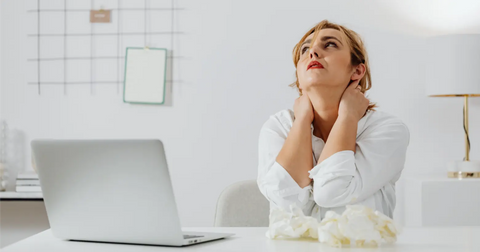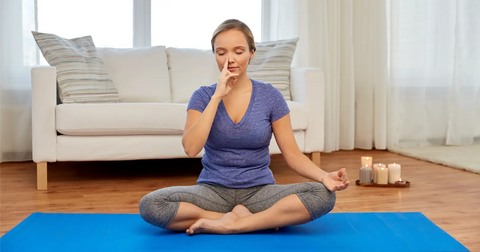Your Cart is Empty
- Shop
- About
- Learn
- Free Domestic Shipping Over $50
- +1(800)929-8935
- Login
- Free Domestic Shipping Over $50
- +1(800)929-8935

While occasional feelings of stress and anxiety are part of the human experience, understanding their intricacies, including how they manifest and influence our lives, is essential for maintaining balance and health.
This article explores stress and anxiety, highlighting their symptoms, differences, and management strategies, including when to seek professional advice.
Equipping ourselves with knowledge and effective coping mechanisms enables us to better navigate these often misunderstood emotions, potentially transforming our approach to dealing with them.
Stress is often likened to the body's alarm system, activated in the face of perceived threats or demands. This activation triggers a cascade of physiological responses designed to prepare you for action—the fight-or-flight mode.1
Physically, you might experience rapid heartbeat, muscle tension, and even digestive issues as your body diverts resources to critical functions. Mentally, stress can manifest as a sense of urgency, difficulty concentrating, or feeling overwhelmed by tasks at hand.
The intensity of these symptoms can vary, often influenced by the nature of the stressor, individual resilience, and coping mechanisms. Recognizing these signs early is key to managing stress before it escalates.
Anxiety, while related to stress, occupies its own unique spectrum of experience. It often presents as a persistent, excessive worry that doesn’t necessarily dissipate when a stressor is removed.
Physically, anxiety symptoms may include trembling, sweating, a rapid heartbeat, and even feelings of breathlessness. Mentally, it casts a shadow of apprehension and dread, leading to incessant worrying or fixating on fears of what might go wrong.2
Unlike the acute response to a specific stressor, anxiety can linger, creating a pervasive sense of unease that affects daily functioning and quality of life.
Physically, the manifestations of anxiety are varied and can be profoundly unsettling. Symptoms often include a noticeable increase in heart rate, leading to palpitations that feel as though your heart is racing uncontrollably. Many also experience trembling or shaking, a natural physical response to perceived threats that can occur even in non-threatening situations.

Sweating and breathlessness are also common, making everyday activities feel laborious and adding to the overall burden of anxiety. These physical symptoms are not just uncomfortable; they can also be mistaken for other health problems, adding another layer of worry.
Mentally, anxiety casts a long, pervasive shadow over one's thoughts and feelings, often leading to a state of constant apprehension or fear. This mental aspect of anxiety is characterized by an inability to stop worrying about future events, fixating on the idea that something bad will happen. This can make concentrating on tasks, making decisions, and engaging in social activities incredibly difficult, as the mind is consumed by negative thoughts and worst-case scenarios.
While stress and anxiety share common physical and mental health symptoms, such as chest pain, high blood pressure, and difficulty concentrating, discerning their key differences is essential for managing these conditions effectively.
Stress typically emerges as a response to an external stressor, like a pressing deadline or a significant argument, and generally recedes once the issue is resolved. This immediate stress response, involving cortisol secretion and the fight or flight mode, is the body's natural reaction to perceived threats.3
In contrast, anxiety often does not have a direct external cause and can linger long after any specific stressor has disappeared, potentially leading to chronic conditions such as generalized anxiety disorder, social anxiety disorder, panic disorder, and other anxiety disorders.3
These conditions are characterized by excessive worry, panic attacks, and other intense anxiety symptoms that require the guidance of a mental health professional.

Recognizing when everyday stress has escalated into an anxiety disorder is crucial, as it indicates the need for intervention strategies that extend beyond conventional stress management techniques.
By clearly understanding the distinctions and connections between stress and anxiety, we not only clarify their effects on our well-being but also empower ourselves to seek suitable care and develop coping strategies.
This proactive approach enhances our mental and physical health resilience, guiding us toward better management of both stress and anxiety in our daily lives.
Effectively managing stress involves a dual approach: tackling immediate symptoms and implementing changes to reduce overall stress. Here are some strategies:4
Physical Activity: Regular exercise is key. It doesn't just combat the physical symptoms of stress; it boosts your mood and improves your overall physical health.
Adequate Sleep: Good sleep is non-negotiable for managing stress. It helps your body and mind recover and reset, making you better equipped to handle stressors. In fact, sleep is the most underrated wellness habit for stress resilience, yet often overlooked in daily routines.
Practicing Mindfulness: Techniques like meditation and mindfulness can anchor you in the now, significantly reducing stress levels and improving your mental health.
Limiting Caffeine: Cutting back on caffeine can prevent spikes in stress levels, keeping high blood pressure and heart palpitations at bay.

Addressing anxiety, particularly when it veers into disorder territory, often calls for more specific approaches:
Talk Therapy: Working with a mental health professional using CBT or exposure therapy can be transformative, offering significant relief from the symptoms of anxiety disorders.5
Breathing Exercises: Simple yet effective, these techniques can be a lifeline during moments of panic or intense anxiety, helping to manage and mitigate symptoms.6
Anti-Anxiety Medications: For some, pharmacological intervention, always under careful medical supervision, is necessary to manage anxiety effectively.7
Preventing stress and anxiety outright might not be feasible, but strengthening your coping mechanisms and cultivating a healthy lifestyle can drastically diminish their impact. Key strategies include:4-7
Regular Physical Activity: Staying active not only boosts your physical well-being but also helps regulate stress and anxiety.
Maintaining Social Connections: Pairing social support with gratitude practices can amplify resilience, as research shows gratitude can rewire your brain toward positivity and strengthen mental health.
Healthy Habits: Getting enough sleep and eating a balanced diet supports your body's defenses against stress and anxiety.

Indeed, several natural strategies can help ease stress and anxiety:
Exposure to Nature: Time spent in green spaces can naturally lower stress levels, promoting relaxation and well-being.
Limiting Caffeine and Alcohol: Reducing intake of these substances can prevent the exacerbation of stress and anxiety symptoms.
Practicing Mindfulness and Meditation: Regular practice can significantly improve your stress and anxiety responses, fostering a sense of calm and presence.
By incorporating these techniques into your daily routine, you can effectively manage stress and anxiety, enhancing your overall quality of life and mental well-being.
If stress or anxiety disrupts your daily life, causes physical symptoms, or leads to excessive worry or fear, it's important to seek medical advice.
A healthcare provider can help diagnose any underlying conditions, such as anxiety disorders or physical health problems, and recommend appropriate treatment options.
While both stress and anxiety are natural responses to the challenges of life, understanding their triggers, symptoms, and the nuances between them allow us to address these emotions more effectively.
By adopting a proactive approach—incorporating regular physical activity, ensuring restorative sleep, practicing mindfulness, and seeking professional guidance when necessary—we empower ourselves to manage these feelings, not just for momentary relief but for long-term well-being.
Recognizing that while we can't always prevent stress and anxiety, we can significantly mitigate their impact through natural and lifestyle-oriented strategies offers a beacon of hope.
Whether it's through reconnecting with nature, moderating our intake of stimulants, or cultivating a supportive social network, the tools for overcoming the negative effects of stress and anxiety lie within our reach.
While you implement these stress management tips, give your brain targeted nutritional support. Seredyn Complete Calm contains natural ingredients that help optimize your emotional pathways for reduced anxiety.
Take a comprehensive approach to stress with Seredyn.
How is stress related to anxiety?
Stress can trigger or exacerbate anxiety, especially in individuals predisposed to anxiety disorders.
What is the 3 3 3 rule for anxiety?
The 3 3 3 rule for anxiety is a simple mindfulness technique: Name 3 things you see, 3 sounds you hear, and move 3 parts of your body to help ground yourself during an anxious moment.
How to avoid stress?
While it's impossible to avoid stress entirely, developing healthy coping mechanisms and maintaining a balanced lifestyle can minimize its impact.
How to relax your mind?
Relaxing your mind can be achieved through practices like meditation, deep breathing exercises, engaging in hobbies, and ensuring quality sleep.
Chu B, Marwaha K, Sanvictores T, et al. Physiology, Stress Reaction. [Updated 2022 Sep 12]. In: StatPearls [Internet]. Treasure Island (FL): StatPearls Publishing; 2024 Jan-. Available from: https://www.ncbi.nlm.nih.gov/books/NBK541120/
Chand SP, Marwaha R. Anxiety. [Updated 2023 Apr 24]. In: StatPearls [Internet]. Treasure Island (FL): StatPearls Publishing; 2024 Jan-. Available from: https://www.ncbi.nlm.nih.gov/books/NBK470361/
Robinson L. (1990). Stress and anxiety. The Nursing clinics of North America, 25(4), 935–943.
Stults-Kolehmainen, M. A., & Sinha, R. (2014). The effects of stress on physical activity and exercise. Sports medicine (Auckland, N.Z.), 44(1), 81–121. https://doi.org/10.1007/s40279-013-0090-5
Kaczkurkin, A. N., & Foa, E. B. (2015). Cognitive-behavioral therapy for anxiety disorders: an update on the empirical evidence. Dialogues in clinical neuroscience, 17(3), 337–346. https://doi.org/10.31887/DCNS.2015.17.3/akaczkurkin
Bentley, T. G. K., D'Andrea-Penna, G., Rakic, M., Arce, N., LaFaille, M., Berman, R., Cooley, K., & Sprimont, P. (2023). Breathing Practices for Stress and Anxiety Reduction: Conceptual Framework of Implementation Guidelines Based on a Systematic Review of the Published Literature. Brain sciences, 13(12), 1612. https://doi.org/10.3390/brainsci13121612
Bandelow, B., Michaelis, S., & Wedekind, D. (2017). Treatment of anxiety disorders. Dialogues in clinical neuroscience, 19(2), 93–107. https://doi.org/10.31887/DCNS.2017.19.2/bbandelow